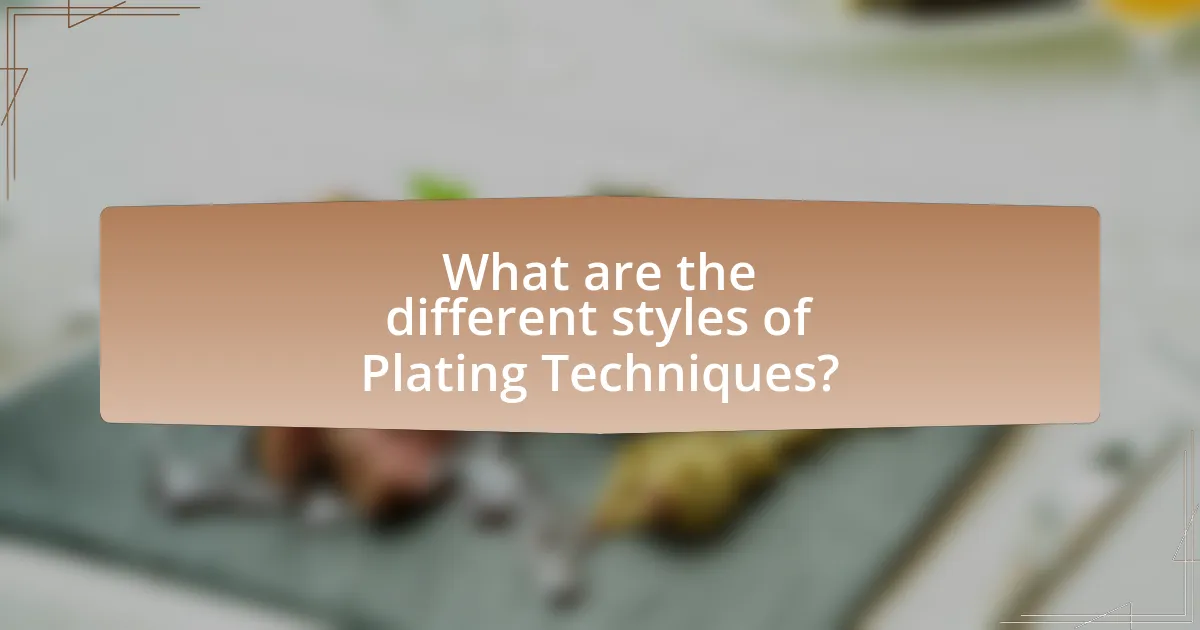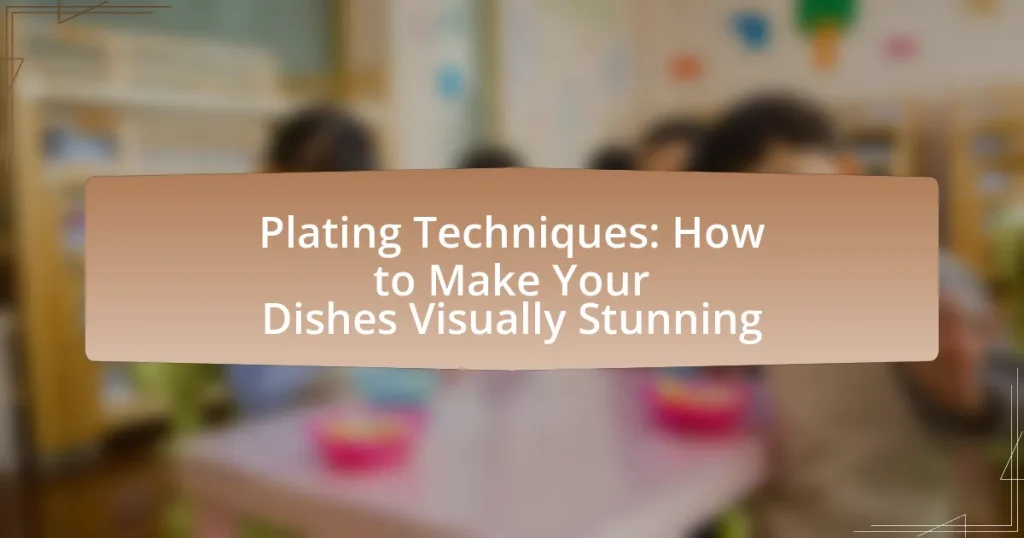Plating techniques are essential methods used to arrange food on a plate in a visually appealing manner, enhancing the overall dining experience. This article explores various plating techniques, including stacking, layering, and the use of negative space, and discusses their psychological effects on diners, such as increased enjoyment and perceived flavor. Key principles of plating, such as balance, contrast, and harmony, are outlined, along with common mistakes to avoid. Additionally, the article highlights different plating styles, tools, and resources for improving plating skills, emphasizing the importance of aesthetics in culinary presentation.

What are Plating Techniques?
Plating techniques are methods used to arrange food on a plate in an aesthetically pleasing manner. These techniques enhance the visual appeal of dishes, making them more enticing to diners. Common plating techniques include stacking, layering, and using negative space to create balance and focus. Research indicates that visually appealing food can enhance the dining experience and increase perceived flavor, as demonstrated in studies published in the journal “Appetite,” which found that presentation significantly affects taste perception.
How do Plating Techniques enhance the dining experience?
Plating techniques enhance the dining experience by transforming food presentation into an art form that engages the senses. Visually appealing dishes stimulate appetite and create anticipation, as studies show that first impressions significantly influence taste perception. For instance, research published in the journal “Appetite” indicates that food served in an aesthetically pleasing manner is often perceived as more flavorful and enjoyable. Additionally, well-executed plating can highlight the ingredients’ colors, textures, and shapes, making the meal more memorable and elevating the overall dining experience.
What psychological effects do visually stunning plates have on diners?
Visually stunning plates have a significant psychological effect on diners by enhancing their overall dining experience and increasing their enjoyment of the meal. Research indicates that visually appealing food can elevate expectations, leading to a perception of better taste and quality. A study published in the journal “Appetite” by Spence et al. (2016) found that the aesthetics of food presentation can influence taste perception, with participants rating dishes as more flavorful when they were presented attractively. This suggests that the visual appeal of a plate can create a positive emotional response, enhancing satisfaction and potentially leading to increased likelihood of return visits to the restaurant.
How does presentation influence taste perception?
Presentation significantly influences taste perception by affecting the way individuals experience flavors and aromas. Research indicates that visually appealing dishes can enhance the perceived taste quality, leading to a more enjoyable eating experience. For instance, a study published in the journal “Food Quality and Preference” by Spence et al. (2016) found that participants rated the taste of food higher when it was presented attractively compared to less appealing arrangements. This suggests that the visual aspects of food, such as color, arrangement, and overall aesthetics, can alter sensory expectations and enhance flavor perception.
What are the key principles of Plating Techniques?
The key principles of plating techniques include balance, contrast, focus, and harmony. Balance refers to the distribution of visual weight on the plate, ensuring that no single element overwhelms the others. Contrast involves using different colors, textures, and shapes to create visual interest and highlight specific components of the dish. Focus directs the viewer’s attention to the most important part of the dish, often achieved through strategic placement and garnishing. Harmony ensures that all elements on the plate work together cohesively, creating a unified presentation. These principles are essential for creating visually stunning dishes that enhance the dining experience.
How does balance play a role in plating?
Balance in plating is essential for creating visually appealing dishes that engage the diner. It involves distributing elements such as color, texture, and size evenly across the plate to achieve harmony. For instance, a well-balanced plate may feature a protein, starch, and vegetable arranged in a way that draws the eye and creates a sense of completeness. Research in culinary arts emphasizes that balanced plating enhances the overall dining experience by making the food more inviting and appetizing, which can lead to increased satisfaction and enjoyment during meals.
What is the significance of color contrast in plating?
Color contrast in plating is significant because it enhances visual appeal and stimulates appetite. High contrast between food colors draws attention to the dish, making it more inviting and engaging for the diner. Research indicates that colorful presentations can increase perceived flavor and enjoyment, as seen in studies where participants rated dishes with vibrant color combinations more favorably than monochromatic ones. This effect is rooted in psychological responses to color, where contrasting hues can evoke emotions and enhance the overall dining experience.
What tools and materials are essential for effective plating?
Essential tools and materials for effective plating include plating rings, tweezers, squeeze bottles, and various garnishes. Plating rings help create structured shapes, while tweezers allow for precise placement of delicate items. Squeeze bottles enable controlled application of sauces, enhancing visual appeal. Additionally, garnishes such as microgreens, edible flowers, and herbs add color and texture, making dishes more visually stunning. These tools and materials are widely recognized in culinary practices for their effectiveness in enhancing presentation.
Which utensils are best for plating?
The best utensils for plating are plating spoons, tweezers, and offset spatulas. Plating spoons allow for precise portion control and can create elegant shapes, while tweezers enable chefs to place delicate garnishes with accuracy. Offset spatulas are ideal for spreading sauces or purees smoothly on the plate. These utensils enhance the visual appeal of dishes by allowing for meticulous arrangement and presentation, which is essential in culinary arts.
What types of plates and serving dishes enhance presentation?
White plates enhance presentation by providing a neutral backdrop that allows the colors and textures of the food to stand out. Additionally, textured plates, such as those with ridges or patterns, can add depth and interest to the visual appeal of a dish. Serving dishes with unique shapes, like asymmetrical or geometric designs, can also create a focal point that draws attention to the food. Research indicates that the color contrast between the plate and the food can significantly affect perceived taste and attractiveness, making the choice of plate crucial for effective presentation.

What are the different styles of Plating Techniques?
The different styles of plating techniques include minimalist, structured, and freeform plating. Minimalist plating focuses on simplicity, using fewer ingredients and negative space to highlight the main dish, often seen in high-end restaurants. Structured plating arranges food in a precise manner, creating a visually appealing layout that guides the eye, commonly used in fine dining. Freeform plating allows for creativity and spontaneity, where ingredients are placed in a more casual, artistic manner, reflecting the chef’s personality. Each style serves to enhance the visual appeal of the dish, making it more enticing to the diner.
How do various plating styles differ from one another?
Various plating styles differ in their presentation techniques, arrangement, and visual impact. For instance, the “classic” style emphasizes symmetry and balance, often using a central focal point, while the “deconstructed” style presents components separately to highlight individual ingredients. The “minimalist” approach focuses on simplicity and negative space, using fewer elements to create a clean look. In contrast, the “rustic” style embraces a more casual, homey feel, often featuring uneven arrangements and natural textures. Each style serves to enhance the dining experience by appealing to different aesthetic preferences and culinary themes.
What is the difference between classical and modern plating styles?
Classical plating styles emphasize symmetry, structure, and the use of traditional garnishes, often presenting food in a way that highlights each component distinctly on the plate. In contrast, modern plating styles focus on creativity, artistic expression, and the use of negative space, often incorporating unconventional arrangements and techniques to create visually striking presentations. This shift reflects a broader trend in culinary arts towards innovation and personalization, as seen in contemporary fine dining where chefs often prioritize visual storytelling and the overall dining experience.
How does cultural influence shape plating styles?
Cultural influence significantly shapes plating styles by dictating the aesthetic preferences, ingredient choices, and presentation techniques unique to each cuisine. For instance, Japanese plating often emphasizes minimalism and balance, reflecting the cultural value placed on simplicity and nature, as seen in traditional kaiseki meals where each dish is artfully arranged to highlight seasonal ingredients. In contrast, Italian plating tends to be more rustic and abundant, showcasing vibrant colors and hearty portions, which aligns with the Italian emphasis on communal dining and celebration of food. These cultural distinctions are further supported by studies, such as those by the Journal of Culinary Science & Technology, which highlight how cultural backgrounds inform not only the flavors but also the visual presentation of dishes, reinforcing the idea that plating is an extension of cultural identity.
What are some popular plating techniques used by chefs?
Some popular plating techniques used by chefs include stacking, layering, and using negative space. Stacking involves placing ingredients on top of each other to create height and visual interest, while layering arranges components in a way that showcases different textures and colors. Negative space refers to leaving empty areas on the plate to enhance the focus on the food, making the dish appear more elegant. These techniques are widely recognized in culinary arts for their ability to elevate the presentation of dishes, thereby enhancing the dining experience.
How is the ‘stacking’ technique applied in plating?
The ‘stacking’ technique in plating involves arranging food items in layers to create height and visual interest on the plate. This method enhances the presentation by drawing the diner’s eye upward, making the dish appear more dynamic and appealing. For instance, chefs often stack ingredients like proteins, vegetables, and garnishes, ensuring that each layer is visible and contributes to the overall aesthetic. This technique not only improves the visual impact but also allows for a variety of textures and flavors to be experienced in each bite, thereby elevating the dining experience.
What is the ‘saucing’ technique and how is it executed?
The ‘saucing’ technique involves the application of sauces to enhance the visual appeal and flavor of a dish. This technique is executed by carefully drizzling, pooling, or smearing sauces on the plate, often using a squeeze bottle or a spoon for precision. For instance, a chef might create a decorative pattern with a sauce by applying it in a controlled manner, ensuring that it complements the food’s presentation while also adding depth to the overall flavor profile. This method not only elevates the dish aesthetically but also engages the diner’s senses, making the meal more inviting and enjoyable.
What are the common mistakes to avoid in plating?
Common mistakes to avoid in plating include overcrowding the plate, neglecting color contrast, and failing to consider the height of the food. Overcrowding can make a dish appear chaotic and unappetizing, while a lack of color contrast can result in a visually dull presentation. Additionally, not incorporating height can lead to a flat appearance, diminishing the visual appeal. Research indicates that visual aesthetics significantly influence perceived taste, highlighting the importance of effective plating techniques.
How can overloading a plate detract from presentation?
Overloading a plate detracts from presentation by creating a cluttered and chaotic visual effect that overwhelms the viewer. When a plate is excessively filled, the individual components of the dish become indistinguishable, making it difficult for the eye to appreciate the colors, textures, and arrangement of the food. Research in culinary arts emphasizes that a well-composed plate should highlight the main ingredients and allow for negative space, which enhances visual appeal. For instance, a study published in the Journal of Culinary Science & Technology indicates that dishes with balanced portions are perceived as more aesthetically pleasing and appetizing.
What are the pitfalls of poor color choices in plating?
Poor color choices in plating can lead to unappetizing presentations that detract from the overall dining experience. When colors clash or lack contrast, dishes may appear unappealing, making it difficult for diners to engage with the food visually. Research indicates that color influences taste perception; for instance, a study published in the journal “Food Quality and Preference” found that colors can affect flavor expectations, with mismatched colors leading to negative perceptions of taste. Additionally, poor color combinations can obscure the freshness and quality of ingredients, resulting in a less favorable impression of the dish.

How can you improve your Plating Techniques?
To improve your plating techniques, focus on the principles of balance, contrast, and composition. Balance involves distributing elements evenly on the plate, ensuring no side feels heavier than the other. Contrast can be achieved through color, texture, and temperature, making the dish visually appealing and engaging. Composition refers to the arrangement of food items, where the placement should guide the viewer’s eye and create a focal point. Research indicates that professional chefs often utilize these principles to enhance the visual impact of their dishes, leading to a more enjoyable dining experience.
What tips can help enhance your plating skills?
To enhance your plating skills, focus on balance, color contrast, and height. Balance ensures that the visual weight of the dish is evenly distributed, creating a harmonious look. Color contrast makes the dish more appealing; for example, pairing vibrant vegetables with neutral proteins can draw attention. Height adds dimension; stacking ingredients or using different textures can create visual interest. Research indicates that well-plated dishes can increase perceived value and enjoyment, as seen in studies on food presentation and consumer behavior.
How can practicing with different ingredients improve your technique?
Practicing with different ingredients enhances your plating technique by allowing you to understand the unique properties and visual characteristics of each component. For instance, experimenting with various colors, textures, and shapes helps you develop a keen eye for balance and composition, which are essential in creating visually stunning dishes. Research indicates that chefs who diversify their ingredient usage can improve their creativity and adaptability in presentation, leading to more innovative plating styles. This hands-on experience fosters a deeper appreciation for how different elements interact on the plate, ultimately refining your overall culinary artistry.
What role does experimentation play in developing your style?
Experimentation is crucial in developing one’s plating style as it allows chefs to explore various techniques, textures, and presentations. By trying different combinations of colors, shapes, and arrangements, chefs can discover unique ways to enhance the visual appeal of their dishes. For instance, a study published in the “International Journal of Gastronomy and Food Science” highlights that visual presentation significantly influences diners’ perceptions of taste and quality. This evidence underscores the importance of experimentation in refining a chef’s aesthetic approach, ultimately leading to more innovative and visually stunning plating techniques.
What resources are available for learning Plating Techniques?
Resources available for learning plating techniques include online courses, culinary schools, instructional books, and video tutorials. Online platforms like MasterClass and Udemy offer courses specifically focused on plating, taught by professional chefs. Culinary schools often incorporate plating techniques into their curriculum, providing hands-on experience. Books such as “The Art of Plating” by Rachael Ray and “Plating for Gold” by Tori Ritchie serve as comprehensive guides. Additionally, YouTube features numerous channels dedicated to culinary arts, showcasing plating techniques in action. These resources collectively enhance understanding and skills in creating visually stunning dishes.
Which books and online courses are recommended for aspiring chefs?
Recommended books for aspiring chefs include “The Professional Chef” by The Culinary Institute of America, which provides foundational culinary techniques and plating skills, and “Plating for Gold” by Taku Sato, focusing specifically on presentation. Online courses such as “Fundamentals of Cooking” on Coursera and “Plating Techniques” on MasterClass offer practical insights into plating and presentation. These resources are widely recognized in the culinary community for their comprehensive content and practical applications, making them valuable for chefs looking to enhance their skills in plating and presentation.
How can social media platforms inspire your plating creativity?
Social media platforms can inspire your plating creativity by providing a vast array of visual examples and innovative ideas from chefs and food enthusiasts worldwide. These platforms, such as Instagram and Pinterest, showcase diverse plating styles, color combinations, and presentation techniques that can spark new concepts and approaches in your own culinary presentations. For instance, a study by the Journal of Culinary Science & Technology found that visual stimuli significantly influence food perception and creativity, indicating that exposure to visually appealing dishes can enhance one’s plating skills and inspire experimentation.
What are some best practices for plating at home?
Best practices for plating at home include using a clean plate, arranging food in a visually appealing manner, and incorporating color contrast. A clean plate enhances presentation and prevents cross-contamination. Arranging food in a way that highlights its textures and shapes, such as stacking or fanning, creates visual interest. Incorporating contrasting colors, like vibrant vegetables against a neutral protein, draws the eye and makes the dish more appetizing. These techniques are supported by culinary experts who emphasize the importance of aesthetics in enhancing the dining experience.










